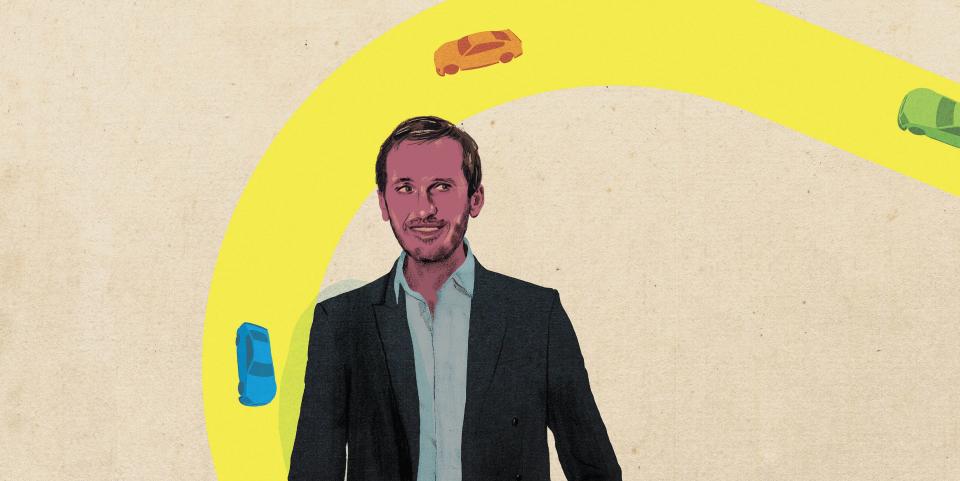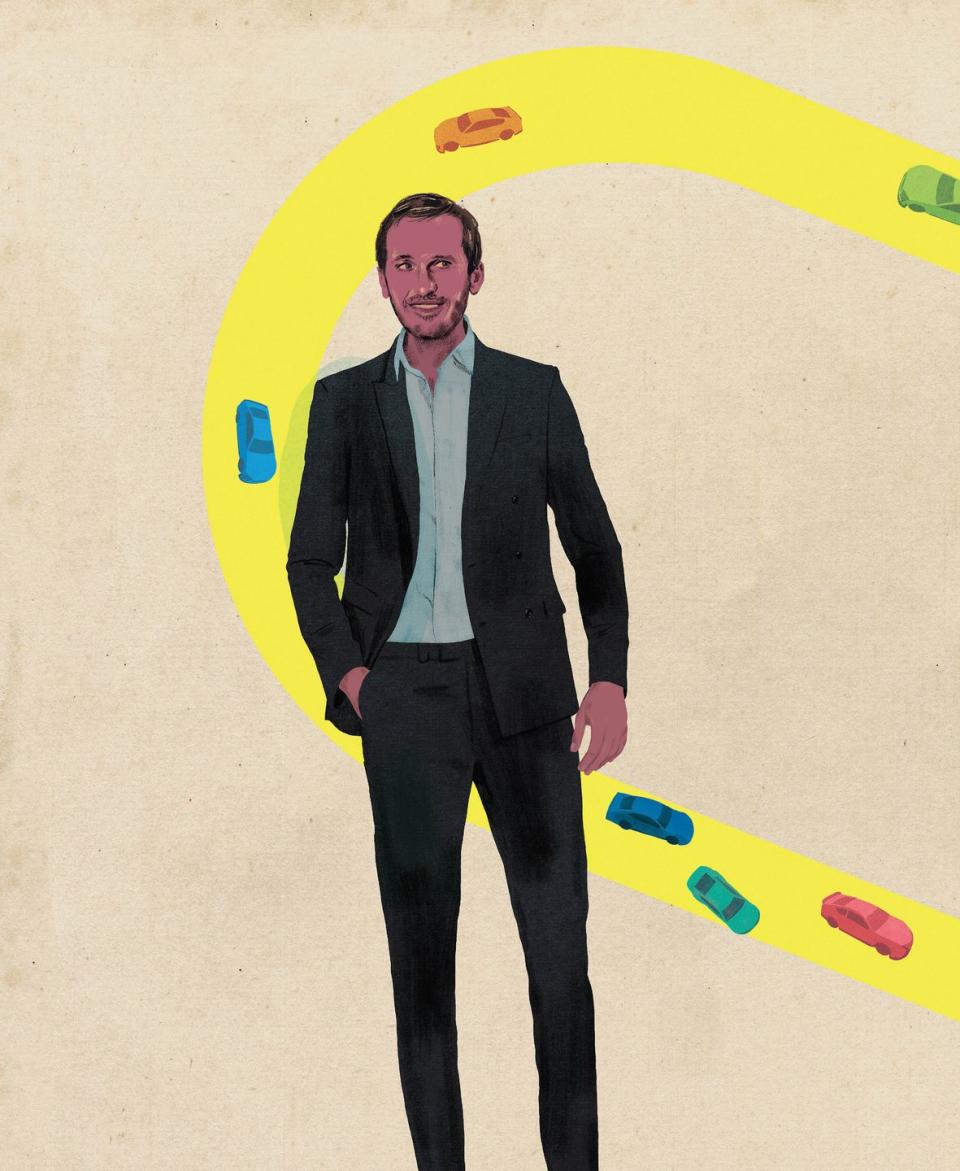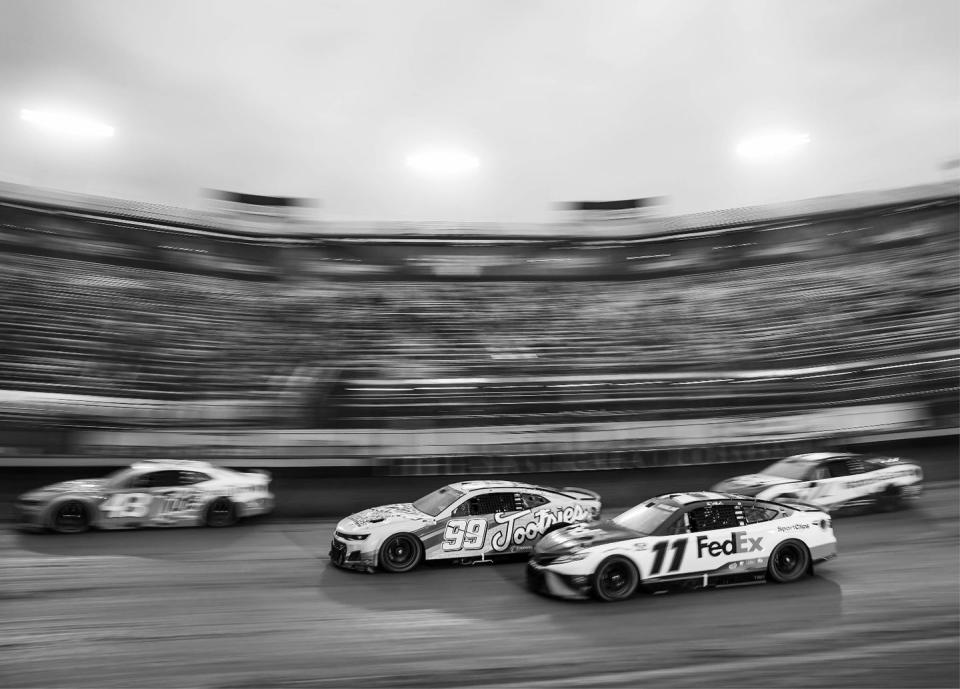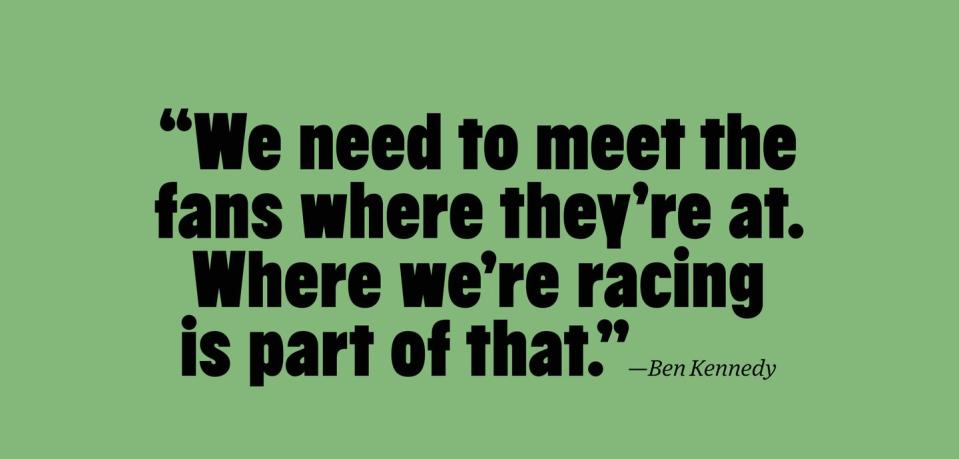Even NASCAR Can’t Escape the Future


Big-league stock-car racing is being revived by a burst of creativity. From dirt covering Bristol’s concrete and an oval inside the Los Angeles Memorial Coliseum to the announcement of the first NASCAR street-circuit race next year in Chicago, a staggering amount of change has already occurred. New cars, new rules, and a whole new corporate structure indicate that the pace of this evolution is unlikely to slow soon.
This story originally appeared in Volume 13 of Road & Track.
SIGN UP FOR THE TRACK CLUB BY R&T FOR MORE EXCLUSIVE STORIES
“It’s not just to say that we need to do things differently,” explains Ben Kennedy, NASCAR’s senior vice president of racing development and strategy [fig. 1]. “But we do need to be constantly asking ourselves whether it makes sense to continue to do things the way we have been. And in many instances it does. But maybe there’s a new technology or new way to be better in certain areas.”
Kennedy, 30, is the son of Lesa France Kennedy, grandson of Bill France Jr., and great-grandson of NASCAR founder Bill France. It’s presumptuous to foresee him inevitably leading the company, but he’s likely to be a big part of the racing brain trust for several decades. Though NASCAR isn’t the strictly family-run business it once was, he is the fourth generation to take up its management. And increasingly, this former racer, University of Florida graduate, and occasional triathlete is the public face of NASCAR management.
“I naturally grew up around the sport,” Kennedy says. “You don’t really think about it a whole lot just because it’s your lifestyle. It’s what you’re used to and what you are. I went racing for 11 years and loved that. I eventually got to a point in my racing career where I was super-passionate about it, and I was finally getting my feet beneath me and being competitive week in and week out. But I had a decision to make: either continue to race or switch over to the business side. For me, it was a lot of contemplating and talking to a lot of folks here at NASCAR to make that decision. I realized that at some point I’m going to wind up on the business side, and what better point to make that leap than when I’m 25 or 26 years old and have a ton of energy, ideas, and passion for the sport? I jumped over, and it was drinking from the fire hose for 12 to 18 months. And I’m still doing that today.”
That NASCAR’s popularity has waned since the Nineties is obvious. Seats have been ripped out of speedways, TV ratings have dropped, and the retirement of fan favorites like Tony Stewart, Dale Earnhardt Jr., and Jeff Gordon has knocked down star power. But NASCAR is still a significant draw in a sports and media environment that’s simultaneously fractured and ripe with opportunity.

NASCAR TV broadcasts still regularly draw two to four million viewers, with the marquee 2022 Daytona 500 attracting a robust 8.9 million sets of eyeballs. Those aren’t pro football numbers; the average NFL game attracts more than 17.1 million fans. Compared with other sports, though, it’s solid. NBA regular-season basketball games average an audience of about 1.6 million, and ESPN is averaging slightly more than 1.5 million viewers for its MLB Sunday Night Baseball. And live sports are about the only way to get young folks to sit down and watch advertiser-supported broadcast television. NASCAR is certainly down from its peak popularity, but it’s nowhere near out.
Still, for NASCAR to grow, it needs a solid, competitive product. And the new seventh-generation race car has helped.
“The car has been tremendous,” says Kennedy. “One, the cars that are on the racetrack on Sunday look a lot more like the production cars that we see on the streets. The Camaro looks much more like a Camaro, the Mustang looks much like a Mustang, and the same thing for the Camry. Whether it’s the body styling or the 18-inch wheels, when you look at these cars on the ground, they look like supercars.
“Secondly, there’s been a big focus on the racing product. Each week after an event, we look at what the fan base is saying and what the fan metrics are coming out of that. Did they like the event?
“And then we have our ‘loop data,’” he explains, referencing radio markers embedded along each track’s length. “As a car goes around the track, there’s a transponder on it, and every time it crosses that loop, we’re getting data from it. How many leaders did we have? How many passes throughout the field? What’s the margin of victory? And if you look at the data from the fans and our own internal metrics, pretty much every one of them is up significantly. In some cases, some of the highest metrics we’ve seen since we began electronic timing in 1993. On top of that, we’ve had, like, 14 different winners so far this year. And I’m probably wrong on that stat.”
Actually, that number is correct at the time of our interview in late July. This year’s list of winners includes first-timers Austin Cindric in the Daytona 500, Chase Briscoe at Phoenix, Ross Chastain at Circuit of the Americas, Tyler Reddick at Road America, and Daniel Suárez on the Sonoma road course. While the new car gets credit, it’s also apparent that a new generation of driving talent has emerged.

“The third and probably most important component is the team model. If you go back to the Gen-6 [cars] that we had last year, the teams almost turned into vehicle manufacturers,” Kennedy continues. “They were manufacturing maybe 90 percent of the parts and components on that vehicle. That’s not to say that on the Next Gen car 90 percent are all single-source supplied. Candidly, the fans don’t really care about the hundreds of hours put into designing an upper control arm; they just want to see good racing and their drivers on the track. There are more of these parts you can buy and assemble and then engineer the vehicle to be competitive. And that has brought in a lot of these new team ownerships we have.”
That in mind, the rise of Formula 1 in American awareness has not gone unnoticed. “Are we making decisions based on what’s happening with F1? No,” Kennedy asserts. “We’re in separate silos making similar decisions. From my perspective, Drive to Survive has had a huge impact, especially here in the United States, to identify with the team and driver. They now know not just the Lewis Hamiltons and Max Verstappens, but every team in there and how important it is for them to be in the top 10.
“They’ve done a really good job on content and innovation—introducing new cars, introducing new tracks like a Miami or Las Vegas. Those are in our own silo of things we’re thinking about, whether it’s going to a new venue like the Los Angeles Coliseum or the Chicago street course or creating new vehicles like the Next Gen car. We will have our own series that’s going to come out this year on USA and Peacock.
“We need to meet the fans where they’re at,” he says. “Where we’re racing is part of that—getting to these larger urban areas while also still celebrating the Talladegas, the Martinsvilles, Bristols, and Daytonas of the world. It’s also what we’re racing. After the Next Gen car, what does the next evolution of that look like? I’m not suggesting the Cup Series will go electric, but you have different powertrains that are evolving and different types of vehicles that are evolving. That’s something we’ll have to decide at a certain point. Does it continue to make sense for us to stay with the same car we have today? Or does that look different? Those are big factors.”
And NASCAR’s ambitions won’t be bound to the United States. “We have series in Canada, Mexico, and Europe,” Kennedy goes on. “We had Brands Hatch, for example, and had our Whelen Euro Series there about a month ago and had over 50,000 people come for the race. And that was the main event of the weekend. There’s a huge opportunity for us internationally. You have a great story with Daniel Suárez coming out of the Mexico Series to the Cup Series. There’s crossover with our existing series, but there are also opportunities for us to go into new markets.”
NASCAR’s TV contracts will be up for renewal after the 2024 season, and with new rich players like Amazon, Apple, and Netflix in the mix, it will be unlike any previous broadcast package. Meanwhile, the Cup Series still lacks a title sponsor.
Michael Jordan and Pitbull both are partners in new teams. Toyota, Chevrolet, and Ford seem firm in their commitments. NASCAR and International Speedway Corporation have rolled up into one publicly traded company, and seat-of-the-pants business decisions are a thing of the past. If Ben Kennedy rises to lead NASCAR, it won’t be because of dynastic inevitability. And it won’t be an easy job.
NASCAR has long been conservative. The last carbureted American passenger vehicles appeared in 1991, yet NASCAR kept running carbs in the Cup Series through 2011. Solid rear axles and 15-inch steel wheels were finally offed this past year. Legends, traditions, and eerily similar mile-and-a-half ovals almost smothered NASCAR.
“Whoever it is who wants to be involved with the sport,” Kennedy says, “should be able to start in a go-kart and have a clear path all the way up to the Cup Series. That’s something we’re missing today. And frankly, that’s a competitive disadvantage. I can go to the sporting-goods store and buy a football for 20 bucks and go to the beach and throw the ball. It’s a little more difficult to get a race car, go to a racetrack, and compete. But there are some ideas and opportunities for us to create that pipeline.”

You Might Also Like

 Yahoo Autos
Yahoo Autos 